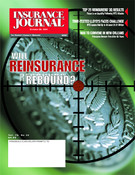In an effort to be noticed in today’s crowded online marketplace, insurance marketers make common, yet fatal, mistakes when constructing websites. While adding the bells and whistles may increase the “wow” factor, this approach contributes little, if anything, to the overall Internet experience. In fact, breaking simple website creative rules may negatively impact how consumers feel about your company, your brand and your products.
The web is a goal-driven medium in which visitors actively attempt to find specific information. It is, therefore, logical to provide the clearest path to that information, making the navigation familiar and intuitive. While it is illogical to distract visitors from accomplishing their goals, most sites do just that. Giving in to the temptation to be creative for creativity’s sake is one of the most common mistakes.
Mistake #1: Too Much Creative
In an effort to give consumers more, novice and veteran marketers alike often go overboard and provide too much “stuff” on their home pages. While delivering benefit-oriented copy and relevant, appealing graphics is a worthy goal, offering consumers a plethora of choices can be downright overwhelming. A visitor will decide, within a matter of seconds, whether to move on through a site. If a consumer is bombarded with too many choices, he or she may abandon the site rather than wade through the content, as good as that content may be.
Mistake #2: Creative That Slows the Experience
The 24/7 nature of the Internet has made today’s consumers impatient. When designing and planning for graphic elements, consider the Nine-Second Rule. If something takes longer than nine seconds to download, there’s a 75-percent or greater chance that you’ll lose your visitor.
Evaluate each graphic element individually by asking how it will impact the consumer’s overall experience. Is the element worth the wait? Conduct mini focus groups with non-marketing people of your target audience to gather valuable feedback. Avoid the temptation to include things for “coolness” sake. What purpose will it have served if a visitor doesn’t have the opportunity to view it?
Also be sure to test your site using older, slower technology. If download times are acceptable, you can feel confident that more advanced systems will not experience downloading delays or problems.
Mistake #3: Creative Provides No Experience
On the flip side of offering too much, there’s the mistake of providing so little interactivity and content that there’s no experience for the visitor. Remember that by its very nature, the Internet is an interactive medium. It’s important to strike a balance between creative overkill and static, flat pages that do little to invite visitors. Consider a consumer’s motivation for visiting your site. Then, create “landing pages” that either deliver on a promise made in your offline advertising efforts or provide an immediate benefit and/or vehicle for responding.
Mistake #4: Creative That Is Distracting
Be ever mindful that all creative elements—copy, graphics, data collection forms, and animation—must facilitate getting consumers to where you want and to do what you want. Visitors who get distracted or lost along the way will eventually bail out. To avoid this scenario, keep web pages simple and ensure that transitions from one place to the next are logical. Plan the flow so that visitors can always get “home” no matter what path they choose.
Consider the audience and their motivations for visiting your site. Is it to request additional information? Will they be applying for your product directly? What do you have to offer that your competitors don’t?
Mistake #5: A Site That’s Hard to Find
In order to experience your site, visitors need to find it. This requires the adoption of a search engine and site indexing strategy. Savvy marketers follow a discipline of regularly updating and managing the search and index variables of sites and frequently submitting sites to search engines. Managing keywords, meta descriptors, repetitive text, contextual copy and content, header and title information and submission are all part of an effective execution of search engine optimization.
Mistake #6: Data Forms That Are Hidden
In web marketing—just as in other modes of direct response advertising—it is still rule #1 to ask for the order. Many of today’s websites disregard this axiom by burying the application form or not including one at all. An online application or request for information should never be more than a click away and should be accessible from every page on the site. The easier you make it for a prospect to respond, the better chance that he or she will.
Was this article valuable?
Here are more articles you may enjoy.


 German Insurtech Wefox to Replace CEO After Board Rejects Mubadala Sales Plan
German Insurtech Wefox to Replace CEO After Board Rejects Mubadala Sales Plan  Microsoft Tells Texas Agencies They Were Exposed in Russian Hack
Microsoft Tells Texas Agencies They Were Exposed in Russian Hack  US Home Insurance Still Priced Too Low for Climate Risk, Says Swiss Re Chair
US Home Insurance Still Priced Too Low for Climate Risk, Says Swiss Re Chair  Allstate, Nationwide Post Dramatic Q12024 Homeowners Loss Ratio Drops: S&P
Allstate, Nationwide Post Dramatic Q12024 Homeowners Loss Ratio Drops: S&P 


